-
SCIENCE
-
QUANTUM CURIOUS
-
NEWS/EVENTS
-
PEOPLE
Observing Pauli Blocking with Cold Collisions
The wavefunction for indistinguishable fermions is anti-symmetric under particle exchange, which directly leads to the Pauli exclusion principle, and hence underlies the structure of atoms and the properties of almost all materials. In the dynamics of collisions between two indistinguishable fermions, this requirement strictly prohibits scattering into 90° angles. By colliding ultracold clouds of fermionic 40K atoms, the team lead by AProf. Niels Kjærgaard and PhD student Ryan Thomas explore this important effect of Pauli blocking by directly measuring the spatial distributions of scattered atoms.

Universal Coarsening in a Spinor Condensate
Universal Coarsening Dynamics of a Quenched Ferromagnetic Spin-1 Condensate, Physical Review Letters 116, 025301 (2016).
A system that has been suddenly quenched can undergo a long period of evolution where domains formed during the quench slowly merge in what is known as coarsening. A spin-1 Bose-Einstein condensates has a rich phase diagram of possible dynamics that under close investigation. In this theoretical work by PhD student Lewis Williamson and Prof. Blair Blakie, a quasi-two-dimensional spin-1 condensate is quenched to a ferromagnetic phase, and shown to undergo universal coarsening in its late time dynamics. The easy-plane phase reveals a fractal domain structure and the crucial role of polar-core spin vortices in the coarsening dynamics.
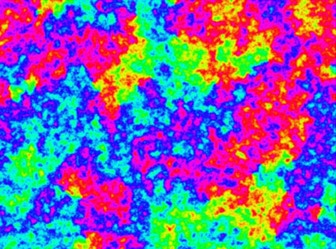
Cooling and Counting Atoms With Light
Optical tecniques for cooling, trapping, and probing atomic samples provide both a high level of control over an ultra-cold quantum system, as well as giving a wealth of information about the atoms in the sample. When atoms scatter light, they generate a form of radiation known as fluorescence. This light carries information about the atoms that scattered it and can thus be used as a sensitive probe of the atoms. A recent experiment led by Andrew Hilliard of the Andersen group has shown how to both cool and count atoms using the same blue-detuned laser field, while the atoms are held by an optical dipole trap.
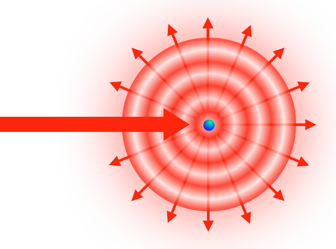
Taming Superfluid Turbulence
Superfluids are super because they lack the normal viscosity that brings flowing fluids to rest. Rapidly moving fliuds exhibit highly chaotic motion, and the starting point for understanding fluid turbulence is the so-called Reynolds number that gives an answer to the question “how turbulent is this fluid?” However the standard Reynolds number only applies to viscous fluids. Work by Matthew Reeves, Ashton Bradley, and their collaborators at Durham and Tucson Universities, has shed new light on superfluid turbulence by identifying a Superfluid Reynolds Number that describes quantum turbulence in a planar superfluid flowing past an obstacle.
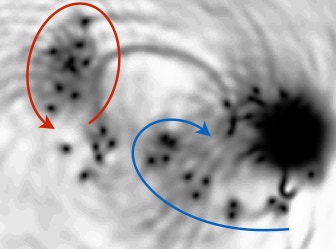
Long Term Quantum Memory
A major step forward in quantum information processing has been achieved in an international colloboration involving Jevon Longdell, and researchers in Australia, USA, France and Germany. The group demonstrated the world’s longest lived quantum memory, able to store quantum information and reliably retrieve it for up to 6 hours. This long coherence time enables quantum information sharing on an unprecedented scale and opens up possibilities for ultra-secure quantum networks. To find out more, visit Quantum information: Spin memories in for the long haul over at Nature News&Views, or watch the One News coverage.
Splitting and Colliding Ultracold Atom Clouds
In an experiment led by Niels Kjaergaard at Otago, physicists have demonstrated highly contrallable spitting and colliding of ultra-cold clouds of atoms. The atoms are manipulated using optical tweezers, allowing the creation of multiple small clouds that may be useful for quantum information processing, for probing surface structures, and for creating sensors to map minute variations in magnetic fields. The team show that multiple clouds (up to 32 in their experiment) can be created and tracked independently with high precision using individually addressed tweezer beams. See coverage at the Otago Daily Times.
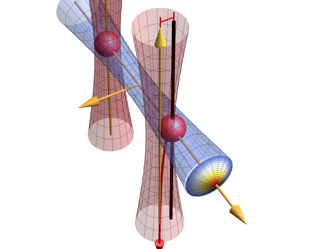
Preparing and Observing Single Trapped Atoms
Near-deterministic preparation of a single atom in an optical microtrap, Nature Physics 6, 951 (2010)
A team led Mikkel Anderson have produced the first near-deterministic preparation of a single atom in a microtrap. They report a loading efficiency of 82.7% for obtaining just one atom held in an optical dipole trap. This efficiency was achived and verified by manipulating pair-wise collisions between atoms using tailored optical fields, and then observing individual atoms by collecting their flouresced light with a high numerical aperture lense. Their work represents a major advance for controlled preparation and manipulation of atoms, and an important step towards building quantum logic devices.
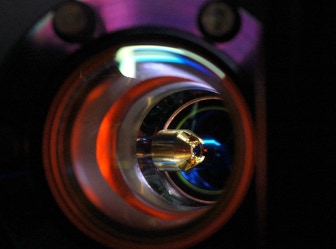
ABOUT QSO
The Centre for Quantum Science is a University of Otago Research Centre hosted by the Department of Physics.
CONTACT
Ashton Bradley
ashton.bradley [at] otago.ac.nz
Niels Kjærgaard
niels.kjaergaard [at] otago.ac.nz